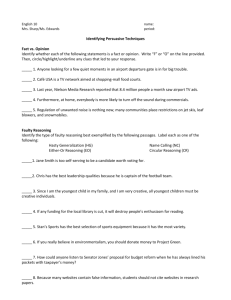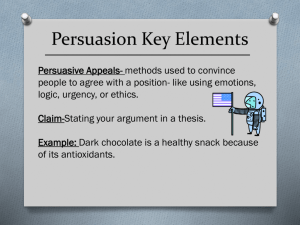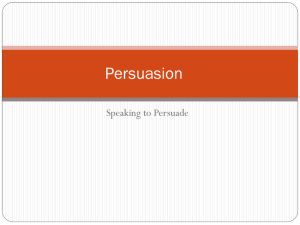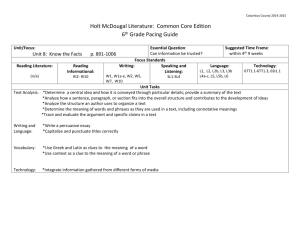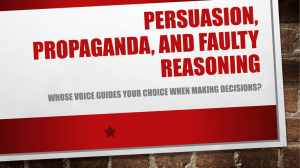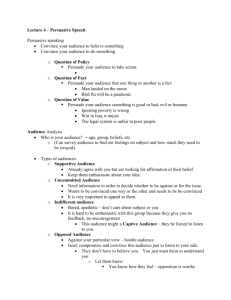persuasive writing
advertisement
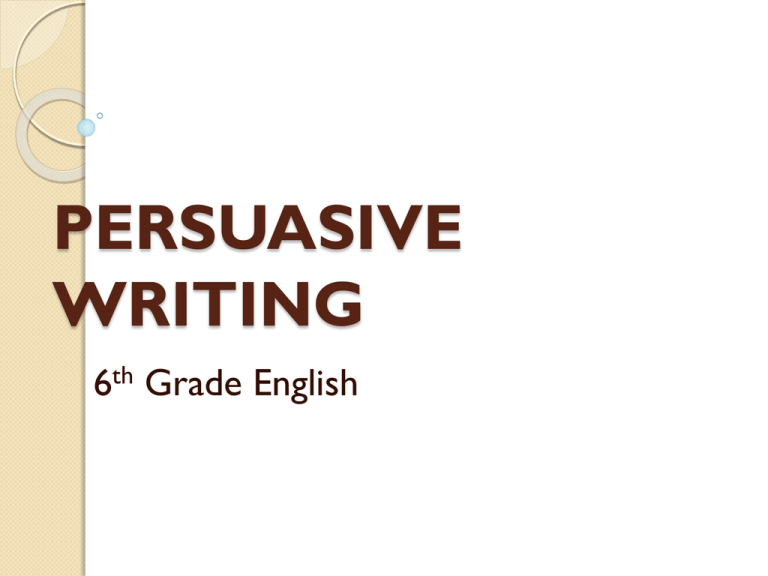
PERSUASIVE WRITING 6th Grade English BE THE TEACHER For this unit, students will become the teachers as we complete a “jigsaw teach” of Persuasive Writing. You will work within your groups to analyze a specific part of the unit. Then, decide how to best teach the other class members so that they have a good understanding of that section. You are responsible for their learning, so make sure you understand it too! BE THE TEACHER I have included some Teaching Thoughts. These are the kinds of things that teachers think about when planning a lesson. As you are analyzing your part of the unit, use these Teaching Thoughts to develop your own lesson so that your students will understand. Use the white poster paper to define new vocabulary, list key points, or draw visual aids. Remember to paraphrase the material so your students can easily read it! I also can provide you with some graphic organizers to help you plan your lesson. Group 1 New Vocabulary claim, argument, viewpoint CLAIM The writer’s position on a problem or an issue. For example, a dog lover’s claim may be that dogs should be allowed in stores in North Richland Hills. The writer may make more than one claim in a text, but usually focuses on supporting ONE claim. Teaching Thought: What does this mean to you? What is an example of a claim you could make? ARGUMENT Speaking or writing that expresses a position on a problem and supports it with reasons and evidence Teaching Thought: Have you ever felt strongly about something, while a friend or family member felt the opposite way? How did you convince that person to see things your way? VIEWPOINT The author’s attitude toward an issue Teaching Thought: Think about the issue of allowing dogs in stores. What do you think the viewpoint of dog owners would be? What about the viewpoint of those who are allergic to dogs? VOCABULARY claim, viewpoint, argument Teaching Thought: Look at the ads in these magazines. What is the advertiser’s claim? How do they argue their claim? What is the advertiser’s viewpoint? Tear out ads that help support your teaching. Group 2 New Vocabulary proposition, support PROPOSITION An important idea, opinion or viewpoint. Basically, a proposition is a statement that expresses someone’s opinion or a change that person would like to see. Let’s say that a dog owner believes dogs should be allowed in all shops in North Richland Hills. He may write a statement that says dogs should be allowed in NRH stores, and mail it to the mayor. PROPOSITION A proposition is a statement. For example: “Because dogs are awesome, dog owners should be allowed to bring their pets to North Richland Hills stores.” Teaching Thought: What are some changes others might propose about a social issue such as smoking, recycling, school issues, etc. How would you write a proposition about a change you would like to see? SUPPORT Information that helps to prove a claim. Support includes reasons and evidence. Writers typically give support for or against an issue. Support includes things like facts, examples, statistics, phrases like “Studies show…” and expert opinions. Teaching Thought: What are some reasons people against allowing dog owners might give to support their claim? Where might they find evidence to back their claim? VOCABULARY proposition, support Teaching Thought: Look at the magazine ads. Does the author/advertiser make a proposition? How do they give support for their proposition? Tear out ads that help support your teaching. Group 3 Persuasive Writing PERSUASION The art of swaying others’ feelings, beliefs or actions. Persuasion convinces people to: •Believe something or act a certain way •Agree with a point of view •Buy a certain product (think advertising!) PERSUASIVE TEXT Text written with the intent to persuade or convince the reader of something. PERSUASIVE TEXT The writer of a persuasive essay presents his or her viewpoint on an issue while trying to persuade the reader to agree with that view. The writer supports his or her view with sound reasoning, detailed and relevant evidence, and consideration of alternatives. PERSUASIVE TEXT Sound reasoning = using facts and evidence to come to a conclusion about something Detailed, relevant information = using documents, statistics, facts, or other hard evidence to support the claim Consideration of alternatives = “Seeing both sides” to an argument PERSUASIVE TEXT To avoid being easily swayed by weak argument, a reader should note the use of vague or unclear language, irrelevant examples, and faulty reasoning used by the author. PERSUASIVE TEXT Teaching Thoughts: What characteristics of a persuasive essay make it different from other types of writing? How can readers avoid being swayed by a weak argument? How can readers decide between a weak argument and a valid one? Group 4 Persuasive Techniques PERSUASIVE TECHNIQUES Devices that can convince you to adopt a position or take an action. Persuasive writers appeal in certain ways to the hearts and minds of their readers: •Logical appeal •Emotional appeal •Appeals to authority •Personal experience LOGICAL APPEAL A way of writing or speaking that relies on facts and logic Teaching Thoughts: Do you think appealing to people’s emotions is a good way to persuade someone? Why? What other examples of emotional appeal have you seen? LOGICAL APPEAL Can you tell the difference between logical appeal and emotional appeal? LOGICAL APPEAL EMOTIONAL APPEAL Uses strong feelings, rather than facts or evidence, to persuade Teaching Thoughts: Do you appealing to people’s emotions is a good way to persuade someone? Why? What other examples of emotional appeal have you seen? APPEALS TO AUTHORITY Tries to persuade the reader on the basis of the author’s expertise Teaching Thoughts: How can a dentist sell toothpaste? How can a celebrity sell skincream? Do you think this type of persuasion is effective? Why? What other examples of appeals to authority have you seen? APPEALS TO AUTHORITY LOADED LANGUAGE Relies on words with strongly positive or negative associations LOADED LANGUAGE POSITIVE WORDS Brings to mind something exciting, comforting, or desirable. NEGATIVE WORDS Call up unpleasant images, experiences, and feelings Can you find the loaded language in these ads? Group 5 Public Service Announcements versus Propaganda PUBLIC SERVICE ANNOUNCEMENT (PSA) Non-commercial media or print advertisement that seeks to generate public awareness of a social issue, such as safety, health or education PUBLIC SERVICE ANNOUNCEMENT (PSA) To summarize… PSAs are created to generate public awareness of a social issue. PUBLIC SERVICE ANNOUNCEMENT PUBLIC SERVICE ANNOUNCEMENT (PSA) Teaching Thoughts Can you recall any PSAs that you have seen? What are some social issues you can think of that the public should be made aware of? Why do you think PSAs are even necessary? Shouldn’t people just be learning about these issues on their own? PROPAGANDA Any form of communication that is so distorted that it conveys false or misleading information to advance a specific belief or cause PROPAGANDA PROPAGANDA Persuasion is the art of leading others to accept a certain idea or take a specific action by appealing to both the mind and emotions of the reader. When persuasion becomes extremely one-sided or unreasonable, it becomes propaganda. Propaganda may include bandwagon appeal, stereotypes, celebrity endorsements and name-calling. PROPAGANDA Bandwagon: Tells readers, “Everybody else is doing it, and so should you!” PROPAGANDA Stereotypes: A widely held, oversimplified idea or image about a particular type of person or thing PROPAGANDA Celebrity endorsements: When a well-known person uses his/her fame to sell a product PROPAGANDA Name-calling: The use of abusive language to take support away from the competitor’s product or claim PROPAGANDA & PSAs Teaching Thoughts: What is the difference between propaganda and PSAs? Why would name-calling and stereotypes be considered propaganda? Why would a celebrity endorsement be considered propaganda? Group 6 Faulty Reasoning FAULTY REASONING Claim based on information that is incorrect, biased or doesn’t make sense Include hasty generalization, overgeneralization, circular reasoning or false cause. FAULTY REASONING This “wrong way of thinking” (or trying to persuade others) is often based on: • Exaggerated statements (a statement that overstates or represents more than what’s true • Misleading statements (a statement that falsely informs the reader) FAULTY REASONING Since advertisements are intended to generate sales, a reader cannot assume that all the information presented is trustworthy. When examining an advertisement, look for logic or correct reasoning backed by reasons and evidence. FAULTY REASONING Overgeneralization: Statements that are so general that they oversimplify reality FAULTY REASONING: Hasty generalization jumping to conclusions FAULTY REASONING: circular reasoning When the writer tries to begin with what they are trying to end with. FAULTY REASONING: false cause: misleading info FAULTY REASONING Teaching Thoughts: Have you ever seen any ads or commercials that seemed just wrong? What did you notice about those commercials? Why is it important to differentiate between logic and faulty reasoning when reading an advertisement? GROUP ACTIVITY You will make a claim about the environment, negative or positive. 1. On your index card, write your appeal and the names of those in your group. 2. Collaborate with your group to take a position on a specific environmental issue. On the index card, write a sentence stating your claim. 3. Use persuasive techniques to support your claim.Your support must be based on your assigned appeal! (emotional, association, loaded language). Debrief questions 1. How does an author craft an effective argument? 2. How does a reader avoid being easily swayed by a weak argument? 3. How do authors use persuasive techniques to make an argument for or against an issue? 4. Why is it important for a reader to read multiple sources on the same topic? Writing response: To avoid being easily swayed by weak argument a reader should note the use of vague or unclear language, irrelevant examples, and faulty reasoning used by the author.
